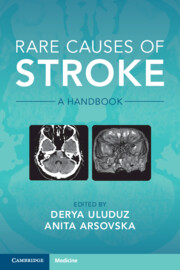Book contents
- Rare Causes of Stroke
- Rare Causes of Stroke
- Copyright page
- Contents
- Contributors
- Preface
- 1 Inflammatory Conditions
- Chapter 1.1 Isolated Vasculitis of the Central Nervous System
- Chapter 1.2 Primary Systemic Vasculitis
- Chapter 1.2 Chapter
- Chapter 1.3 Vasculitis Secondary to Systemic Disease
- 2 Infectious and Postinfectious Vasculitis
- 3 Hypercoagulable Causes of Stroke
- 4 Drug-Related Stroke
- 5 Hereditary and Genetic Causes of Stroke
- 6 Rare Causes of Cardioembolism
- 7 Vasospastic Conditions and Other Vasculopathies
- 8 Other Non-inflammatory Vasculopathies
- 9 Venous Occlusive Conditions
- 10 Bone Disorders and Stroke
- Index
- References
Chapter 1.2 - Chapter
from 1 - Inflammatory Conditions
Published online by Cambridge University Press: 06 October 2022
- Rare Causes of Stroke
- Rare Causes of Stroke
- Copyright page
- Contents
- Contributors
- Preface
- 1 Inflammatory Conditions
- Chapter 1.1 Isolated Vasculitis of the Central Nervous System
- Chapter 1.2 Primary Systemic Vasculitis
- Chapter 1.2 Chapter
- Chapter 1.3 Vasculitis Secondary to Systemic Disease
- 2 Infectious and Postinfectious Vasculitis
- 3 Hypercoagulable Causes of Stroke
- 4 Drug-Related Stroke
- 5 Hereditary and Genetic Causes of Stroke
- 6 Rare Causes of Cardioembolism
- 7 Vasospastic Conditions and Other Vasculopathies
- 8 Other Non-inflammatory Vasculopathies
- 9 Venous Occlusive Conditions
- 10 Bone Disorders and Stroke
- Index
- References
Summary
Takayasu’s arteritis (TAK) is a large vessel vasculitis (LVV), often granulomatous, predominantly affecting the aorta and/or its major branches. It usually affects patients younger than 50 years (90% women) but the clinical, histopathological and pathogenetic features are similar to giant cell arteritis (GCA). Indeed, age at onset > 50 years and coexistent polymyalgia rheumatica are the main clinical points to differentiate between TAK and GCA. Immunohistopathology of aortic samples reveals tissue infiltration by cytotoxic lymphocytes in involved vessels. The first vascular lesion is usually reported in the left subclavian artery (SA) with a progression to left CCA, VA, brachiocephalic trunk, right middle or proximal SA, right CCA, VA, and aorta. The transmural inflammation of the vessel can lead to stenosis, occlusion or dilation of involved portions of the arteries. Despite the availability of tools for disease definition, diagnostic criteria for clinical use and classification criteria for research use there is still a need for validated diagnostic criteria for systemic vasculitides. At the time of diagnosis, approximately 20% of patients are asymptomatic; the most common findings at presentation are absence or asymmetry of peripheral pulses, limb claudication, visual symptoms. General constitutional symptoms (fatigue, weight loss and low-grade fever) and are common in the early phase of the disease. Laboratory abnormalities are nonspecific and generally reflect chronic inflammatory process with increased levels of ESR and C-reactive-protein (CRP). Both ultrasound, neuroradiological imaging and nuclear medicine imaging are often necessary for the diagnosis and for the follow-up of vessel invovement
Keywords
- Type
- Chapter
- Information
- Rare Causes of StrokeA Handbook, pp. 17 - 23Publisher: Cambridge University PressPrint publication year: 2022



